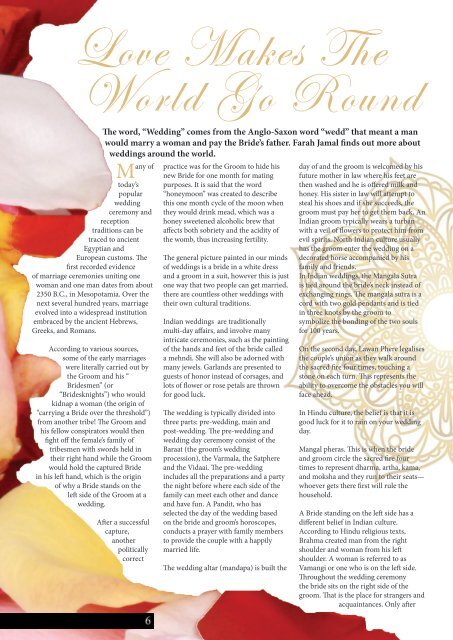EXTROVERT WINTER 2017
Leeds City College Year 2 Journalism students produce a magazine for the college student community.
Leeds City College Year 2 Journalism students produce a magazine for the college student community.
Create successful ePaper yourself
Turn your PDF publications into a flip-book with our unique Google optimized e-Paper software.
Love Makes The<br />
World Go Round<br />
Many of<br />
today’s<br />
popular<br />
wedding<br />
ceremony and<br />
reception<br />
traditions can be<br />
traced to ancient<br />
Egyptian and<br />
European customs. The<br />
first recorded evidence<br />
of marriage ceremonies uniting one<br />
woman and one man dates from about<br />
2350 B.C., in Mesopotamia. Over the<br />
next several hundred years, marriage<br />
evolved into a widespread institution<br />
embraced by the ancient Hebrews,<br />
Greeks, and Romans.<br />
According to various sources,<br />
some of the early marriages<br />
were literally carried out by<br />
the Groom and his “<br />
Bridesmen” (or<br />
“Bridesknights”) who would<br />
kidnap a woman (the origin of<br />
“carrying a Bride over the threshold”)<br />
from another tribe! The Groom and<br />
his fellow conspirators would then<br />
fight off the female’s family of<br />
tribesmen with swords held in<br />
their right hand while the Groom<br />
would hold the captured Bride<br />
in his left hand, which is the origin<br />
of why a Bride stands on the<br />
left side of the Groom at a<br />
wedding.<br />
The word, “Wedding” comes from the Anglo-Saxon word “wedd” that meant a man<br />
would marry a woman and pay the Bride’s father. Farah Jamal finds out more about<br />
weddings around the world.<br />
After a successful<br />
capture,<br />
another<br />
politically<br />
correct<br />
practice was for the Groom to hide his<br />
new Bride for one month for mating<br />
purposes. It is said that the word<br />
“honeymoon” was created to describe<br />
this one month cycle of the moon when<br />
they would drink mead, which was a<br />
honey sweetened alcoholic brew that<br />
affects both sobriety and the acidity of<br />
the womb, thus increasing fertility.<br />
The general picture painted in our minds<br />
of weddings is a bride in a white dress<br />
and a groom in a suit, however this is just<br />
one way that two people can get married,<br />
there are countless other weddings with<br />
their own cultural traditions.<br />
Indian weddings are traditionally<br />
multi-day affairs, and involve many<br />
intricate ceremonies, such as the painting<br />
of the hands and feet of the bride called<br />
a mehndi. She will also be adorned with<br />
many jewels. Garlands are presented to<br />
guests of honor instead of corsages, and<br />
lots of flower or rose petals are thrown<br />
for good luck.<br />
The wedding is typically divided into<br />
three parts: pre-wedding, main and<br />
post-wedding. The pre-wedding and<br />
wedding day ceremony consist of the<br />
Baraat (the groom’s wedding<br />
procession), the Varmala, the Satphere<br />
and the Vidaai. The pre-wedding<br />
includes all the preparations and a party<br />
the night before where each side of the<br />
family can meet each other and dance<br />
and have fun. A Pandit, who has<br />
selected the day of the wedding based<br />
on the bride and groom’s horoscopes,<br />
conducts a prayer with family members<br />
to provide the couple with a happily<br />
married life.<br />
The wedding altar (mandapa) is built the<br />
day of and the groom is welcomed by his<br />
future mother in law where his feet are<br />
then washed and he is offered milk and<br />
honey. His sister in law will attempt to<br />
steal his shoes and if she succeeds, the<br />
groom must pay her to get them back. An<br />
Indian groom typically wears a turban<br />
with a veil of flowers to protect him from<br />
evil spirits. North Indian culture usually<br />
has the groom enter the wedding on a<br />
decorated horse accompanied by his<br />
family and friends.<br />
In Indian weddings, the Mangala Sutra<br />
is tied around the bride’s neck instead of<br />
exchanging rings. The mangala sutra is a<br />
cord with two gold pendants and is tied<br />
in three knots by the groom to<br />
symbolize the bonding of the two souls<br />
for 100 years.<br />
On the second day, Lawan Phere legalises<br />
the couple’s union as they walk around<br />
the sacred fire four times, touching a<br />
stone on each turn. This represents the<br />
ability to overcome the obstacles you will<br />
face ahead.<br />
In Hindu culture, the belief is that it is<br />
good luck for it to rain on your wedding<br />
day.<br />
Mangal pheras. This is when the bride<br />
and groom circle the sacred fire four<br />
times to represent dharma, artha, kama,<br />
and moksha and they run to their seats—<br />
whoever gets there first will rule the<br />
household.<br />
A Bride standing on the left side has a<br />
different belief in Indian culture.<br />
According to Hindu religious texts,<br />
Brahma created man from the right<br />
shoulder and woman from his left<br />
shoulder. A woman is referred to as<br />
Vamangi or one who is on the left side.<br />
Throughout the wedding ceremony<br />
the bride sits on the right side of the<br />
groom. That is the place for strangers and<br />
acquaintances. Only after







